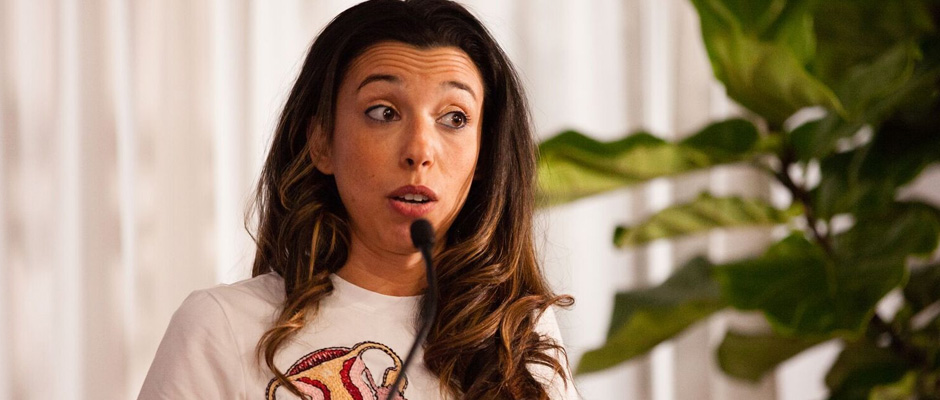PATIENT AWARENESS DAY 2018: LIVING YOUR BEST LIFE WITH ENDO
Sunday, March 18, 2018, (8am-5pm) Einhorn Auditorium (131 E76th st) at Lenox Hill Hospital, NYC
Endo Warrior One: Finding your inner warrior through yoga to battle endometriosis
- Thank you. I'm really impressed all the speakers that come up here without notes. So, you guys are great. I have notes that I'm going to cheat off of because I get really nervous when I talk, so I'm sweating and I'm gassy. Somehow the fact that you all know that makes me feel better. My name is Brandilee. I am a yoga teacher, and I have endometriosis. Yoga and endo for me are one in the same. And it wasn't always that way. I never saw yoga as a way to treat my endometriosis, to manage my pain. In fact if someone had told me, you know, you're in a lot of pain, try some yoga, I would've been like, "I can't get out of bed, let alone do some funky flamingo stuff on a yoga mat." So I never saw the two colliding. I would practice yoga when I was feeling good. So if that was a couple weeks, I was really lucky. More likely it was a couple days here and there. But I still got a benefit, an emotional benefit, it helped with my stress, when I did practice yoga. So I decided to go for a teacher training. Due to a series of unfortunate events, I ended up having an excision surgery six weeks before I was about to be certified in power yoga, which is a very fast paced and athletic vinyasa. And I feel like there's doctors in here looking at me, saying, that's a terrible idea. I know, I was screwed. So I went down to my teacher training hardly being able to do a sit-up let alone go through this really fast paced yoga class. And it ended up being the best thing that could have ever happened to me. I was suddenly forced to talk about my endometriosis. I had to tell my instructors, my teachers why I wasn't participating, why I was taking these really restorative poses when I was supposed to be doing a really fast class. I was then telling my fellow classmates, I have endometriosis. This is what I have to do. And it was really the first time in my life that I listened to my body. I honored my body and did exactly what I needed. A lot of times yoga teachers will say that in their class. Listen to your body. Take it at your pace. And that can be really difficult when you're looking around and you have people standing on their heads, someone's levitating, I don't know. It's hard when you're just like, I just need to stay in this one pose. Because I can't do anything else. But during this time when I was down there I had no choice but to listen to my body because my body was healing. And that's when I really learned what yoga was about. It's not about being flexible or being able to balance on your pinky or touch your toes. It's nothing like that. It's listening to you. I also learned the philosophy behind the practice. They say there's eight limbs to the philosophy of yoga. Three of them really stand out to me when it come to endometriosis. It's Asana, Pranayama and Dhyana. Pranayama are breath exercises to control or enhance Prana, which is a life energy. This is beneficial to endo because breathing exercises are used to minimize pain since deep exhalation promotes relaxation, while releasing tension. Increased awareness of your breathing also helps alleviate pain and calm the nervous system. So right away that is not what people typically think of for yoga. They think of these poses, it's breathing, it's breath, it all starts right here. Another limb is Dhyana, which is meditation. Meditation is often helpful during pain flares. You can actually have a pain-guided meditation to talk you through the breathing and where you're channeling your energy during a painful flare. And then there's Asana, which is the physical postures used to balance the energy in your body and prepare the body and mind for meditation. I'm going to focus on those postures during this presentation, and I'm going to share a sequence that may be used to help alleviate pain. Women with endometriosis will have different physical abilities at different times of the month, different times of the day. And before I share the sequence I do wanna stress that yoga cannot cure endo. We know that. There are bad days. There are still bad days for me when I can't even get out of bed. But even on my worst days, there are elements of this sequence that I'm going to share with you that I can still tap into and bring into my bad day while I am lying in bed. I think anyone here who has endometriosis knows that even if you have the slightest, tiniest relief of pain, it helps. You'll take anything at that point. And I hope that from this sequence you'll be able to take something. So finding a physical and mental ease through the yoga can feel empowering and really redefine your relationship between endo and self. As I said, the two for me are forever one in the same. So I'm going to welcome an ally of the endo community, an advocate for women's health, and my best friend in the entire world, Courtney Small, to the stage, to demonstrate, to go through this sequence. There we go. Alright. We are going to start in child's pose. So, kneel on the floor, touch your big toes together, and sit with your hips on your heels. Then separate your knees about as wide as your hips. Exhale and lay your torso down between your thighs. Broaden your sacrum across the back of your pelvis, and narrow your hip points towards the navel, so that they nestle down onto the inner thighs. Lay your hands on the floor alongside your torso, palms up, and release the fronts of your shoulders towards the floor. This pose stretches the hips, the thighs, and the ankles. You're also gently relaxing the muscles on the front of the body while softly stretching the muscles of the back torso. When you look at this pose, how many people in here have endo? If you'd care to share. Okay. How many times does that look like you curled up in bed on your side? Right? So this is a yoga pose. This is a posture that can actually help with your pain. Now if you can't get out of bed, you can do this in your bed. You can also put pillows and blankets right between your knees so you're laying on top of them and hugging them with your body. From here we're going to push back into a tabletop position. So your shoulders are right above your hands, your hips right above your ankles. And we're going to begin by moving into cow pose. So, inhale as you drop your belly towards the mat. Lift your chin, your chest, gaze up towards the ceiling. Broaden across your shoulder blades, and draw your shoulders away from your ears. Next were going to move into cat pose. As you exhale, draw your belly to your spine and round your back toward the ceiling. The crown of your head releases toward the floor. Inhale coming back to cow pose. And then exhale as you return to cat pose. In addition to stretching the hips and the abdomen, this repetitive movement helps to calm the mind. You can repeat this sequence five, ten, 20 breaths. And you'll feel a nice release. We're going to meet with a flat back, tabletop. And then with an exhalation, root through the L's of your hand, tuck your toes, and push back. Oh my gosh, I'm not even moving this. Sorry, this is That we were just going through. And now we are in downward facing dog. Sorry about that. So firm your outer thighs, and roll the upper thighs inward slightly. Narrow the front of your pelvis. Firm your shoulder blades against your back, then widen them and draw them toward your tailbone. Keep the head between the upper arms. Don't let it hang. You actually have an option here. If you have pillows, you can stack the pillows and rest your head on top of the pillows. This posture is great for symptoms such as headaches, insomnia, back pain and fatigue. From here, slowly, one step at a time, you're going to walk to the top of your mat. Standing with your feet mat distance apart, toes pointing out You're going to squat all the way down. This is Malahsana. Place your hands in a prayer. Position in front of your body so your arms and elbows are pushing your legs and creating space in this posture. This pose opens up the pelvic area to help remove tension from the groin. It also increases circulation, which can help ease pain. If this pose is difficult in any way, you can sit on a block or you can stack some blankets up and rest on there. From here... I'll get the hang of this by the end, I swear. Sit down on the floor with your back straight and your legs wide before you. This is a wide legged seated forward pull. Stretch the legs out as far possible until you can feel the stretch. Your toes are pointed upwards and the legs firmly pressed against the floor. Slowly bend at the waist. This opens and releases the pelvis. Keep your upper body straight and aligned, and you'll have a full body stretch which can relax the body. You can stay here for a minute. You can stay here for five minutes. Whatever feels best for you. You're getting a whole body stretch here. And now from here, there we go, you're going to slowly rise back up, straight back, and then you're going to take a butterfly pose by bringing the soles of your feet together. Your knees go out wide. They create a nice diamond shape. From here lean backward using your elbows for support. And then go all the way down to the ground. Bring one hand to your belly, one hand to your heart. You can also, what I really like to do in this pose is bring my hands towards my uterus. And it's almost like I'm telling myself to breathe into that area. Where my hands are I'm breathing. I'm breathing deep. And you can stay here for five, ten minutes. This is the most common pose that I'll take when I'm laying in bed trying to get through a terrible flare. To get out of this, close your knees like a book. Roll over to the side, and push yourself up to a seated position. Now I focused on the Asana part of class. Okay. Because that's what most people identify with yoga, is these poses. But earlier I mentioned Pranayama, which is deep breathing. So before we break for lunch, or break for a break, which is what we're doing next, we can take a little 20 second, I want to get everyone involved. So we're all going to do an exercise known as long, deep breathing. So the long, deep breathing technique is important because many of us tend to breathe too shallow, especially when you're in pain. Your whole body tightens up and you're holding your breath. When you breathe long and deeply, you activate the relax and rest mode of your nervous system. The muscles start to relax and your mind becomes calmer. So I'm going to ask everyone to start by sitting up nice and straight. Both feet on the floor. Flat on the floor. Place one had on your abdomen, one hand on your chest, and softly close your eyes. Going to inhale through the nostrils and feel the lower part of your lungs expanding the abdomen. Continue to inhale and fill the middle lungs and feel that the chest is expanding and the abdomen is shrinking slightly. Continue to inhale and fill the upper lung and feel your collarbones lifting a little bit. Now exhale and reverse. First the collarbones sink, followed by the chest, and last the abdomen. And we're going to hold here for two beats. One, two. Now begin to inhale. You start with the abdomen, you go up to your chest. You fill your upper lungs, and you exhale. Lungs, chest, abdomen. Do this twice on your own, you can count as you do it. One, two, three. Three, two, one. Hold it for two beats. One, two, three. Three, two, one. While you're doing this deep breathing exercise, I like to recite a mantra. And a mantra is just something you can say over and over to yourself. And the one that I love to use is "I am enough." I am enough. So while I'm breathing in, my first breath to fill my abdomen, is I, my chest, am, my upper lungs, enough. So many times with endometriosis, you feel like you are not enough. You feel incomplete. You feel broken, that your body has betrayed you. But staying with your breath, I am enough. And you are enough. So when you learn to take these deep, slow breaths, your muscles relax and you'll find it's difficult to maintain a lot of physical tension when you're breathing properly. Fresh oxygen pours into every cell in the body with every deep, relaxed breath. This increases the functionality of every system in the body. I have also teamed up with the Endo Foundation to put on Endo Warrior One events, which are yoga classes to raise awareness, and in these classes we go over a lot of these poses and a lot of these techniques.










